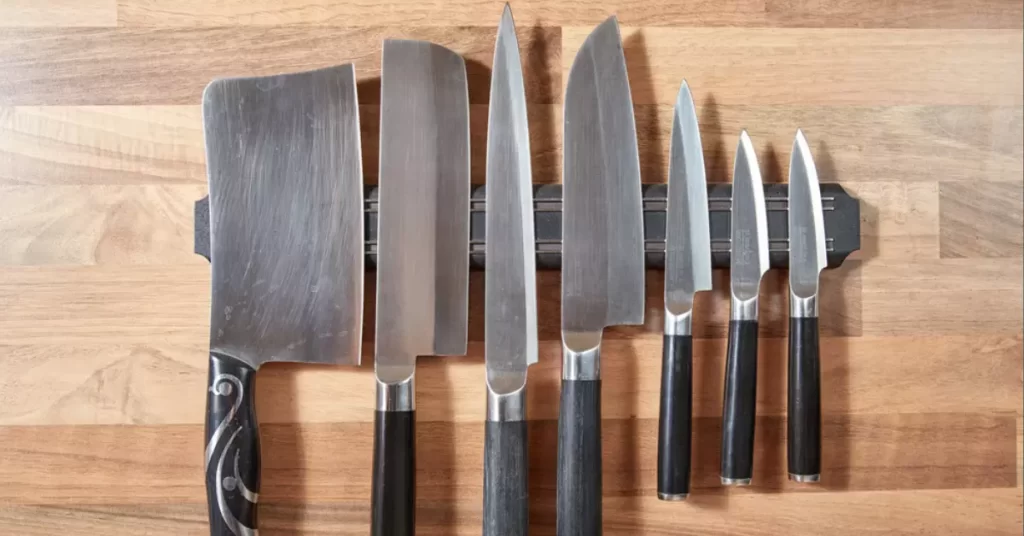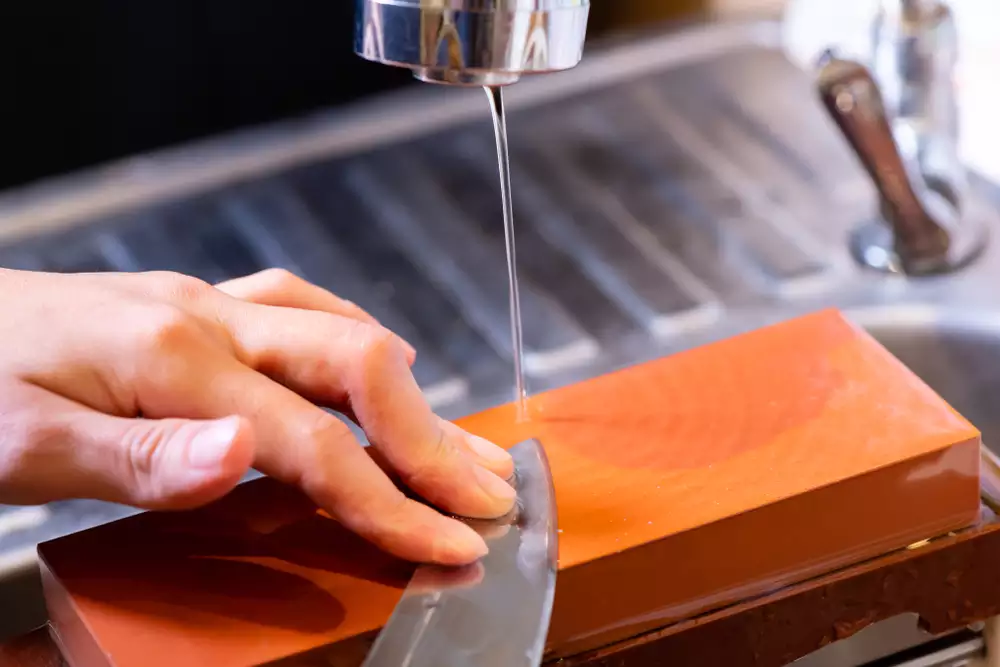The battle of the blade has begun! 15 vs 20-degree knife edge, which should you choose? This age-old debate has chefs, home cooks, and knife enthusiasts alike pondering the best choice for their kitchen.
In this comprehensive guide, we’ll slice through the confusion and provide you with everything you need to know about these two popular knife edge angles.
Get ready to sharpen your knowledge and make an informed decision that will keep your kitchen cutting edge!
Understanding Knife Edge Angles
Before diving into the differences between 15 and 20-degree knife edges, it’s important to understand what the edge angle means.
The angle is measured from the centerline of the blade to the edge. A smaller angle means a sharper edge, while a larger angle results in a more durable edge.
Thus, a 15-degree edge is sharper than a 20-degree edge, but may not be as sturdy.
The 15-Degree Edge
Advantages
Sharper edge: The 15-degree angle creates an incredibly sharp edge, perfect for precision cutting tasks like slicing delicate fish or ultra-thin vegetable julienne.
Faster cutting: The thinner edge allows for smoother and quicker cutting, making food preparation more efficient.
Japanese knives: Many high-quality Japanese knives feature 15-degree edges, which are renowned for their exceptional sharpness and craftsmanship.
Disadvantages
Durability concerns: Due to the thin edge, 15-degree knives can be more susceptible to chipping or dulling, especially when used on hard ingredients or cutting surfaces.
Requires more maintenance: To keep the edge sharp and free from damage, frequent honing and sharpening is necessary.
Not ideal for heavy-duty tasks: The 15-degree edge is not well-suited for tasks like chopping through bones or thick-skinned vegetables.

The 20-Degree Edge
Advantages
Greater durability: The thicker 20-degree edge is more resistant to chipping and dulling, making it suitable for a wider range of cutting tasks.
Less frequent maintenance: Due to its sturdiness, the 20-degree edge requires less honing and sharpening compared to a 15-degree edge.
Versatility: This edge angle is commonly found in Western-style knives and is versatile enough to handle a variety of kitchen tasks, from slicing to chopping.
Disadvantages
Less sharp: While the 20-degree edge is more durable, it sacrifices some sharpness compared to the 15-degree edge. This may result in slightly less precise cuts, especially for delicate ingredients.

Comparing 15-Degree vs 20-Degree Knife Edges
| Aspect | 15-Degree Edge | 20-Degree Edge |
| Sharpness | Very Sharp | Sharp |
| Durability | Less Durable | More Durable |
| Maintenance | Frequent | Less Frequent |
| Best for | Precision Cutting Tasks | General Kitchen Tasks |
Factors to Consider When Choosing a Knife Edge Angle
Your cooking style
Assess the type of cutting tasks you perform most often in your kitchen. If you frequently work with delicate ingredients and require precise cuts, a 15-degree edge may be more suitable.
However, if you need a versatile, all-purpose knife, a 20-degree edge is likely a better choice.
Maintenance habits
If you’re willing to regularly hone and sharpen your knives to maintain their edge, you might enjoy the benefits of a 15-degree angle.
On the other hand, if you prefer less frequent maintenance, a 20-degree edge may be a more practical option.
Knife construction
The blade material and construction play a significant role in the performance of a knife. High-quality Japanese knives often feature 15-degree edges, while Western-style knives typically have 20-degree edges. Consider the type of knife that best suits your preferences and needs.
How to Maintain Your Knife’s Edge Angle
Regardless of the edge angle you choose, proper maintenance is crucial to keep your knives sharp and effective. Here are a few maintenance tips:
Hone regularly
Use a honing rod to realign the knife’s edge every few uses. This helps maintain the edge’s sharpness without removing metal from the blade.
Sharpen when needed
Over time, honing will no longer be sufficient to maintain your knife’s sharpness. When this occurs, use a sharpening stone or professional sharpening service to restore the edge.
Use an appropriate cutting surface
To prevent damage to your knife’s edge, use a cutting surface like a wooden or plastic cutting board. Avoid using glass, ceramic, or metal surfaces.
Comparing 30-Degree vs 40-Degree Knife Edges
30-degree and 40-degree knife edges are less common but can still be found in specialty knives or for specific purposes. Here, we’ll compare the two angles:
30-Degree Edge
Sharper than 20-degree but less sharp than 15-degree: The 30-degree edge offers a balance between sharpness and durability. It is suitable for general-purpose kitchen tasks, but not as precise as a 15-degree edge.
Moderate durability: The 30-degree edge is more durable than the 15-degree edge but less so than the 20-degree edge. It can handle a variety of cutting tasks without chipping easily.
Moderate maintenance: The 30-degree edge requires more maintenance than a 20-degree edge but less than a 15-degree edge. Regular honing and periodic sharpening will keep it in good shape.
40-Degree Edge
Least sharp of all discussed angles: The 40-degree edge is the least sharp among the angles discussed in this article. However, it can still be useful for certain applications where extreme sharpness is not a priority.
High durability: The 40-degree edge is the most durable of the angles discussed. It is resistant to chipping and can withstand heavy-duty cutting tasks, such as breaking down large cuts of meat or chopping through hard ingredients.
Least frequent maintenance: Due to its durability, the 40-degree edge requires the least amount of maintenance among the edge angles discussed. Occasional honing and sharpening will suffice to maintain its cutting performance.
Specialized applications: Knives with a 40-degree edge are often used for specific purposes, such as butchering or woodworking, where durability is more important than sharpness.
FAQs
Can I change my knife’s edge angle?
Yes, you can change the edge angle of your knife by re-sharpening it with a sharpening stone or using a professional sharpening service.
However, keep in mind that changing the angle may affect the knife’s performance and durability. It is essential to consider the blade material and construction before altering the edge angle.
How do I know the edge angle of my knife?
The edge angle is often specified by the manufacturer. You can check the packaging, user manual, or the manufacturer’s website for this information.
If you can’t find the information, you can estimate the angle by looking at the bevel of the blade or consulting a professional knife sharpener.
How often should I sharpen my knife?
The frequency of sharpening depends on the knife’s edge angle, the materials being cut, and how often the knife is used.
As a general rule, you should sharpen your knife when honing no longer restores its sharpness. For most home cooks, this could be every few months to once a year.
Final Verdict
Choosing the right knife edge angle for your needs comes down to your cooking style, maintenance habits, and personal preferences.
A 15-degree edge offers exceptional sharpness for precision cutting tasks but requires more maintenance and care.
A 20-degree edge is versatile and durable, suitable for various kitchen tasks with less frequent maintenance. If you’re looking for something in between, a 30-degree edge may be a suitable compromise.
As for the 40-degree edge, it is best suited for specialized applications where durability is paramount. Remember that no matter which angle you choose, proper maintenance will ensure your knives remain sharp and effective for years to come. Happy slicing!
